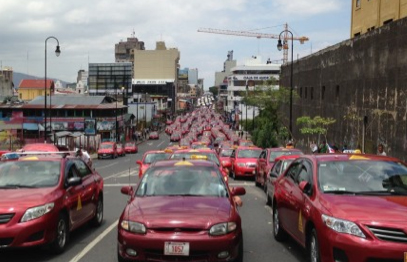So, who manipulates data? Government, business (individual or entire industry as we constantly see in martial arts/self-defense), media, social organizations with agenda. They utilize a grouping of information to create a narrative on a topic for specific reason, most often of benefit to them. The data itself could be entirely legitimate and authentic (though it may not be)….it’s how it’s spun that’s important, and most people rarely dig deeper and go “Hey, wait a minute, that doesn’t sound right….” Remember, there are multiple benefits to data manipulation and if it fits a person’s narrative, they will often support their angle of it even if it’s different from the original source that was manipulating the data in the first place.
With regards to crime, the entities information-alter for any number of reasons: to create or change a market or push value of product (security/arms/training/surveillance), to alter public-opinion (shift-of-perspective/vote-swaying/neighborhood growth), to reinforce personal/individual message, to play on public emotion (fear/anxiety/paranoia as propaganda), to create perceived need where there isn’t one. It’s often done very subtly yet suddenly. Remember “Inception”, that Christopher Nolan movie from a few years ago? “An idea is like a virus. Resilient. Highly contagious. And even the smallest seed of an idea can grow.”

How is it done? Data can come in any number of ways and it always pays to research who the data was provided by and any satellite bodies backing or financing that data and why, what the sample-size is, and who stands to benefit by putting out said data. From the data-source, spinning a positive or negative message by selecting a skewed/cherry-picked portion of the data is often done. So is subtly changing the narrative of what that data actually means. This is accomplished by using a small sample-size to represent an entire geographic area, or to “chunk-up”/generalize and try to distract from a full-analysis of data as it pertains to a specific location/time/demographic. So what are some examples of this in the area of crime and violence?
*Telling people that an increase in in a certain kind of crime (murder, for instance) reflects a widespread elevation of violence, that crime is universally on the rise. Questions that need be asked: In what area? All parts of the city/province-state/country? Who’s getting murdered – is it a specific demographic? What were some choices made by the victim that could’ve altered the What were the victims doing, where, why, and when? Shouldn’t each case be assessed independently from others – with context and circumstance?

*Issuing public-warnings or alerts to alleviate responsibility. When there were 3 separate female tourists killed here, I received almost immediate notice from the Canadian government, issuing security warning on higher-risks of violence in CR to Canadian residents and ex-patriots. Not even close, though I get why they’re obligated to do this for their citizens abroad. All 3 incidents were unique unto themselves, isolated, contributed to by at least some victim-naivete, and crimes of opportunity. That was late last year, 2018. There have been no further tourist-murders since. Calm has been restored. No epidemic occurred. CR tourism has not generally suffered..as could be expected. And the panic has gone quiet. But I bet the security, arms, and surveillance industries flourished for a time….and future votes were gained for the political-party righting the ship so quickly. (I’m not sure what they actually did but they promised lots originally and sometimes that’s enough, akin to a placebo) Questions that need be asked: Does it affect me directly? Are isolated incidents a reflection of the overall national safety? Who have been the targets and what could they have done differently? Do statistics reflect this warning?
*Creating false data from scratch. A few years ago when we had a medical tourism facilitation business, the statistics for foreign medical-procedure investment grew every year, according to the national medical-tourism promotional body. Often in double-digits. But whenever you’d contact the very same hospitals administration department where the statistics were supposedly compiled from, they were entirely perplexed, noting openly that they certainly weren’t the ones benefiting from this claimed increase. Note the promotional body projects these statistics globally (important for market-confidence), they’ve tried to get funding from the government-run international tourism board for years but to no avail (someone doesn’t seem to be buying the stats sheet), and they were in danger of becoming redundant (which they now are as they’ve been replaced by a broader-perspective body not at all limited to a small market-specialization) Questions that need asking: Data taken from? Source? Compiled by? Based on what sample size and from whom? Done by outside impartial entity?
*Media fear-mongering. Sensationalizing one story to build anxiety, stress, and fear in a market for viewership, popularity, and ratings. This is often the most transparent and easy-to-catch if one is coherent and questioning. Here we have a newspaper that posts dead bodies on the front page, shows open murdered corpses, half-naked women on the front, and glorifies violence. While one would think it wouldn’t have legs in a staunchly Catholic, conservative, passive-aggressive society….it’s quite the opposite. Remember, “all press is good press” for many and they’ve found a comfortable niche regardless of the comments on classlessness and inappropriateness abounding. Questions that need asking: How are their ratings? Do they have a history of hyperbole? What’s their personal agenda and what are their general political leanings? Who owns the station? How could they benefit from my knee-jerk reaction to their sensationalism?
*Propaganda is byproduct of the avenues above and it can intentionally increase crime and violence as well. As we saw here in CR a short time ago, one video on Youtube from a supposed paramilitary group, coupled with (intentional?) rumors of natural resource/supply-and-demand shortages, government corruption, and a nervous population…and violence can be the product, not the cause. When you have political de-stabilization, lack of faith in the status quo and videos/pamphlets/fake news omnipresent, certain societal factions can be mobilized to rebel and unify. Governments, groups, and businesses know this. Violence can be created as well, rest assured.
Martial artists and self-defense authorities are noted for making vast, general claims about the state of current society to peddle fear and stress in potential clients….without the data. Crime is always rising. Murders are way up. Rapes are on the increase and women are in-danger. We’ve never lived in a more dangerous time. If you’re not learning (their) self-defense you’re naive and ignorant and nonchalant and should be shamed for not wanting to protect your family and lazy and a host of other ad-hominems they throw your way to guilt you into investing. There’s generally no data to back this up as, on the human timeline, we generally live in the safest time in recorded human history. They heard it on a promotional-snippet, heard a friend say it, have personal trouble avoiding conflict in their own life, relate their experiences and needs to every potential student’s, and a host of other context-delusional assessments that pertain specifically to them. Questions to ask: what style are they peddling? What program (women’s self-defense, seniors, kids, adult males) What’s their market? Do statistics and data back their claims? Does the current community level of violence jive with their promo-material?
The reality is that we “manipulate data” all the time. We generalize, distort, and delete parts of stories and anecdotes regularly to fit our narrative, manipulate (I mean, convince or influence….semantics, right) others, or convince ourselves of something we’re indecisive or unsure about. Communication is filled with these methods of filtering information….sometimes it helps us positively, sometimes not. Sometimes these perceptual filters are generally accurate, sometimes entirely off whether intentional or unintentional. So we do them as well….ad nauseum…to create our reality. We’re all experts at data-manipulation and propaganda, especially to ourselves. That being said, it should give proper perspective to take closer looks at information you’re fed…with an unbiased eye, or at least as unbiased as that eye can be.
Asking these questions and identifying the type of message and data being pushed go a long way towards understanding intricately the dynamic of how people can manipulate data and utilized propaganda to promote message….even on crime and violence. From what I see daily, current technological distractions and information-bombardment, coupled with personal factors like confirmation bias(es), decreasing attention-spans, micro-relatability – are huge factors in others’ ability to pull this off successfully. Relating to our personal safety and (especially) our stable mental health relating to it, be extremely cautious with the (often subliminal-)messaging you’re bombarded with. And ask the right questions….
(Thanks to Oleg Fadeev for the topic-inspiration.)







